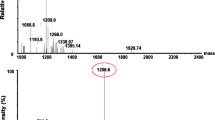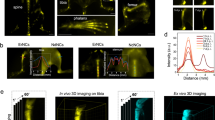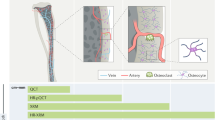Abstract
In vertebrates, the development and integrity of the skeleton requires hydroxyapatite (HA) deposition by osteoblasts. HA deposition is also a marker of, or a participant in, processes as diverse as cancer and atherosclerosis. At present, sites of osteoblastic activity can only be imaged in vivo using γ-emitting radioisotopes. The scan times required are long and the resultant radioscintigraphic images suffer from relatively low resolution. We have synthesized a near-infrared (NIR) fluorescent bisphosphonate derivative that exhibits rapid and specific binding to HA in vitro and in vivo. We demonstrate NIR light–based detection of osteoblastic activity in the living animal and discuss how this technology can be used to study skeletal development, osteoblastic metastasis, coronary atherosclerosis and other human diseases.
This is a preview of subscription content, access via your institution
Access options
Subscribe to this journal
Receive 12 print issues and online access
$209.00 per year
only $17.42 per issue
Buy this article
- Purchase on Springer Link
- Instant access to full article PDF
Prices may be subject to local taxes which are calculated during checkout





Similar content being viewed by others
References
Marks, S.C. & Popoff, S.N. Bone cell biology: the regulation of development, structure and function in the skeleton. Am. J. Anat. 183, 1–44 (1988).
Jakoby, M.G. & Semenkovich, C.F. The role of osteoprogenitors in vascular calcification. Curr. Opin. Nephrol. Hypertens. 9, 11–15 (2000).
Watson, K.E. Pathophysiology of coronary calcification. J. Cardiovasc. Risk 7, 93–97 (2000).
Jung, A., Bisaz, S. & Fleisch, H. The binding of pyrophosphate and two diphosphonates by hydroxyapatite crystals. Calcif. Tissue Res. 11, 269–280 (1973).
Fleisch, H. Bisphosphonates—history and experimental basis. Bone (Suppl. 1) 8, S23–S28 (1987).
Altkorn, D. & Vokes, T. Treatment of postmenopausal osteoporosis. JAMA 285, 1415–1418 (2001).
Eastell, R. Treatment of postmenopausal osteoporosis. N. Engl. J. Med. 338, 736–746 (1998).
Mundy, G.R. & Yoneda, T. Bisphosphonates as anticancer drugs. N. Engl. J. Med. 339, 398–400 (1998).
Klenner, T., Wingen, F., Keppler, B.K., Krempien, B. & Schmahl, D. Anticancer-agent-linked phosphonates with antiosteolytic and antineoplastic properties: a promising perspective in the treatment of bone-related malignancies? J. Cancer Res. Clin. Oncol. 116, 341–350 (1990).
Fujisaki, J. et al. Osteotropic drug delivery system (ODDS) based on bisphosphonic prodrug. I: synthesis and in vivo characterization of osteotropic carboxyfluorescein. J. Drug Target. 3, 273–282 (1995).
Fujisaki, J. et al. Physicochemical characterization of bisphosphonic carboxyfluorescein for osteotropic drug delivery. J. Pharm. Pharmacol. 48, 798–800 (1996).
Fujisaki, J. et al. Osteotropic drug delivery system (ODDS) based on bisphosphonic prodrug. III: Pharmacokinetics and targeting characteristics of osteotropic carboxyfluorescein. J. Drug Target. 4, 117–123 (1996).
Fujisaki, J. et al. Osteotropic drug delivery system (ODDS) based on bisphosphonic prodrug. V. Biological disposition and targeting characteristics of osteotropic estradiol. Biol. Pharm. Bull. 20, 1183–1187 (1997).
Fujisaki, J. et al. Osteotropic drug delivery system (ODDS) based on bisphosphonic prodrug. IV. Effects of osteotropic estradiol on bone mineral density and uterine weight in ovariectomized rats. J. Drug Target. 5, 129–138 (1998).
Hirabayashi, H. et al. Bone-specific delivery and sustained release of diclofenac, a non-steroidal anti-inflammatory drug, via bisphosphonic prodrug based on the Osteotropic Drug Delivery System (ODDS). J. Control. Release 70, 183–191 (2001).
Bachman, C.H. & Ellis, E.H. Fluorescence of bone. Nature 206, 1328–1331 (1965).
Prentice, A.I. Autofluorescence of bone tissues. J. Clin. Pathol. 20, 717–719 (1967).
Chance, B. Near-infrared images using continuous, phase-modulated and pulsed light with quantitation of blood and blood oxygenation. Ann. N.Y. Acad. Sci. 838, 29–45 (1998).
Lin, J.H., Duggan, D.E., Chen, I.W. & Ellsworth, R.L. Physiological disposition of alendronate, a potent anti-osteolytic bisphosphonate, in laboratory animals. Drug Metab. Dispos. 19, 926–932 (1991).
Mahmood, U., Tung, C.H., Bogdanov, A. & Weissleder, R. Near-infrared optical imaging of protease activity for tumor detection. Radiology 213, 866–870 (1999).
Miwa, N. et al. In Patent Cooperation Treaty WO 00/16810 (2000).
Reilly, D.T. & Burstein, A.H. The elastic and ultimate properties of compact bone tissue. J. Biomech. 8, 393–405 (1975).
McKern, N.M. Comparison of skeletal growth in normal and “little” mice. Growth 46, 53–59 (1982).
Cleynhens, B. et al. 99mTc-bone agents with rapid renal excretion. In Technetium, rhenium and other metals in chemistry and nuclear medicine. (eds Nicolini, M. & Mazzi, U.) 611–614 (Servizi Grafici Editoriali, Padova, Italy; 1999).
Quaresima, V., Matcher, S.J. & Ferrari, M. Identification and quantification of intrinsic optical contrast for near-infrared mammography. Photochem. Photobiol. 67, 4–14 (1998).
Farkas, D.L. et al. Non-invasive image acquisition and advanced processing in optical bioimaging. Comput. Med. Imaging Graph. 22, 89–102 (1998).
Ntziachristos, V., Yodh, A.G., Schnall, M. & Chance, B. Concurrent MRI and diffuse optical tomography of breast after indocyanine green enhancement. Proc. Natl. Acad. Sci. USA 97, 2767–2772 (2000).
Sabatakos, G. et al. Overexpression of DeltaFosB transcription factor(s) increases bone formation and inhibits adipogenesis. Nat. Med. 6, 985–990 (2000).
Olsen, B.R., Reginato, A.M. & Wang, W. Bone development. Annu. Rev. Cell. Dev. Biol. 16, 191–220 (2000).
Gunther, T. & Schinke, T. Mouse genetics have uncovered new paradigms in bone biology. Trends Endocrinol. Metab. 11, 189–193 (2000).
Drake, W.M., Kendler, D.L. & Brown, J.P. Consensus statement on the modern therapy of Paget's disease of bone from a Western Osteoporosis Alliance symposium. Clin. Ther. 23, 620–626 (2001).
Karrer, S. et al. Photochemotherapy with indocyanine green in cutaneous metastases of rectal carcinoma (in German). Dtsch. Med. Wochenschr. 122, 1111–1114 (1997).
Abels, C. et al. Indocyanine green (ICG) and laser irradiation induce photooxidation. Arch. Dermatol. Res. 292, 404–411 (2000).
Rogers, M.J. et al. Cellular and molecular mechanisms of action of bisphosphonates. Cancer 88, 2961–2978 (2000).
Martin, M.B. et al. Bisphosphonates inhibit the growth of Trypanosoma brucei, Trypanosoma cruzi, Leishmania donovani, Toxoplasma gondii and Plasmodium falciparum: a potential route to chemotherapy. J. Med. Chem. 44, 909–916 (2001).
Lim, D.J. & Saunders, W.H. Otosclerotic stapes: morphological and microchemical correlates. An electron microscopic and x-ray analytical investigation. Ann. Otol. Rhinol. Laryngol. 86, 525–540 (1977).
Ikehira, H., Furuichi, Y., Kinjo, M., Yamamoto, Y. & Aoki, T. Multiple extra-bone accumulations of technetium-99m-HMDP. J. Nucl. Med. Technol. 27, 41–42 (1999).
Dupouy, P., Geschwind, H.J., Pelle, G., Gallot, D. & Dubois-Rande, J.L. Assessment of coronary vasomotion by intracoronary ultrasound. Am. Heart J. 126, 76–85 (1993).
Rockson, S.G. et al. Photoangioplasty for human peripheral atherosclerosis: results of a phase I trial of photodynamic therapy with motexafin lutetium (Antrin). Circulation 102, 2322–2324 (2000).
Acknowledgements
We thank Daniel S. Kemp and Stephan D. Voss for helpful discussions and Alec DeGrand, Ananda Lugade, Christopher Mantzios, Kerry Petersen, Daniel Draney, Michelle Pastore, Alice Carmel, David Lee-Parritz, Angeline Warner, Stephen Moore, J. Anthony Parker, Rachel Katz-Brull, Barry Alpert, Victor Laronga, Michael Paszak, Patrick Verdier, Paul Nothnagle, Paul Millman, Kenneth Wilson, Victor Yen, Maxx Abraham and Fernando Delaville for technical assistance. We thank Rebekah Taube for proofreading and Grisel Rivera for administrative assistance. A.Z. is a Radiology Training Grant Fellow of the National Cancer Institute (NCI). A.M. and A.G.J. acknowledge support from US Public Health Service (US PHS) grant R01CA/34970. J.V.F. is supported by the Howard Hughes Medical Institute, Doris Duke Charitable Foundation (nonanimal experiments), Paul D. and Lovie S. Kemp Career Development Fund for Prostate Cancer, the Hershey Family Foundation, the Rita Leabman Memorial Fund and a grant from the NCI (R21CA88245).
Author information
Authors and Affiliations
Rights and permissions
About this article
Cite this article
Zaheer, A., Lenkinski, R., Mahmood, A. et al. In vivo near-infrared fluorescence imaging of osteoblastic activity. Nat Biotechnol 19, 1148–1154 (2001). https://doi.org/10.1038/nbt1201-1148
Received:
Accepted:
Published:
Issue Date:
DOI: https://doi.org/10.1038/nbt1201-1148
This article is cited by
-
Quasi-dendritic sulfonate-based organic small molecule for high-quality NIR-II bone-targeted imaging
Journal of Nanobiotechnology (2023)
-
Functional and analytical recapitulation of osteoclast biology on demineralized bone paper
Nature Communications (2023)
-
Near-infrared luminescence high-contrast in vivo biomedical imaging
Nature Reviews Bioengineering (2023)
-
Correlative light and electron microscopic observation of calcium phosphate particles in a mouse kidney formed under a high-phosphate diet
Scientific Reports (2023)
-
Emerging NIR-II Luminescent Gold Nanoclusters for In Vivo Bioimaging
Journal of Analysis and Testing (2023)



